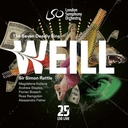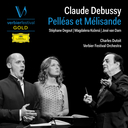Fifteen years have passed since Deutsche Grammophon released Magdalena Kozena’s first solo album of songs from her native land, the Czech Republic, as it wasn’t called when she was born in 1973. It’s hard to recognise the heavily mascara-ed and lipsticked blonde bombshell pictured on the disc booklet as the Kozena I am meeting on a glorious day in Berlin, near the home she shares with Sir Simon Rattle and their three children (two tweenage boys and a 15-month-old daughter).
Kozena — a constant, if not overfrequent, presence in London since her international breakthrough around 2000 — will be spending a lot of time in the capital during the coming concert season. Only two nights ago, she joined Rattle and the Vienna Philharmonic as the Angel in Elgar’s The Dream of Gerontius at the Proms. I wonder aloud if her apparent ubiquity is connected with Rattle’s gradual move — musically speaking, at any rate — from the Berlin Philharmonic to the London Symphony Orchestra in the run-up to his appointment here from September 2017.
“No, not at all,” she says. “It’s a coincidence. I was asked by the Wigmore Hall to be artist in residence, which is nothing to do with Simon!”
The Wigmore events (the last actually at Wilton’s Music Hall, in the East End) are certainly ambitious. The first of her four programmes, with Mitsuko Uchida at the piano, and performed twice (October 2 and 5), covers a remarkable range of repertoire. The opening recital combines Schumann and Wolf with Dvorak and Schoenberg, whose cabaret songs point to the final concert in the series, at Wilton’s, The Melody Makers, for which she will be joined by a big band in songs by Cole Porter. Rattle is scheduled to make his hall debut in works combining piano and other instruments by Chausson, Ravel, Brahms — the beautiful late songs — and Dvorak (January 29). That’s the plan, anyway.
“Well, yes, he is. Um, if he’s ever going to practise!” She laughs. “I think he will have to, because it’s already in print that he will play.”
Perhaps the most imaginative part of the series is her collaboration with Andrea Marcon’s Italian group, La Cetra, with whom she will perform works by the baroque master Monteverdi and the modernist Luciano Berio (March 8). She relishes the prospect of such diversity. “Absolutely. These days, it’s quite rare in classical music to have an opportunity to do a project like this. I said, we don’t want to do conventional concerts, we want to do something special and crazy, so that’s why I ended up with Cole Porter and a semi-staged Monteverdi-Berio programme.”
The inspiration for the latter seems to be the cult American mezzo Cathy Berberian, Berio’s sometime wife and muse, for whom he wrote vocal works of staggering technical difficulty, including Sequenza III, which Kozena will sing. Berberian was also an eloquent Monteverdian, appearing on Nikolaus Harnoncourt’s trailblazing recordings of The Coronation of Poppea and Orfeo. Kozena clearly sees herself as a kindred spirit, spanning the beginnings of Italian solo vocal music to the avant-garde.
“Some singers like to concentrate on one period or repeat a handful of roles, but it would not be for me. I like to mix things up and bring my experience of the baroque to modern music, for example.”
When DG first released her Czech songs album, she had already recorded a (self-financed) disc of Bach arias with a period-instrument ensemble, eventually issued on its specialist Archiv label. So the desire to cover a wide range of repertoire was there from the start. “The truth is that I began as a baroque singer, which was unintentional, really. I became involved with the period-instrument scene, which was quite small at that time in my country, certainly compared with England and Germany. We were experimenting and discovering things for ourselves that Harnoncourt and Gardiner had discovered 20 years before, but because of the Iron Curtain, we couldn’t get their CDs and didn’t know what was going on. It was a fascinating time to explore without influences.”
Kozena has since broadened her horizons, but baroque music lies at the root of her artistic outlook. “It’s a good beginning for every singer. Not only vocally — it’s healthy for the voice, not too heavy, the coloratura is good for keeping your voice in shape — but you also learn things like improvising, ornamenting, the things that are creative, the way you treat language. In Monteverdi, for example, you learn the best way to sing Italian, in his famous recitar cantando [sung recitation].”
Kozena’s solo performance of Monteverdi’s Il combattimento di Tancredi e Clorinda is a big vocal challenge, and a theatrical one as well. This dramatic “madrigal” for three singers (narrator and title roles) can be convincingly done by one performer.
“I know I’m not the first, and I would never have suggested it myself — it was the idea of Andrea Marcon. I’ve already sung it solo in concert, but I think it’s hard to understand that there are three different persons, so the staging will help. We’ve started rehearsals with a Czech director I’ve known for many years. He’s a famous actor in my country and has a jazz band, so they will be playing Cole Porter for me. He might even sing a few pieces in that programme, because that is his main job.”
Next year, she teams up with Rattle for semi-staged (by Peter Sellars) performances of Debussy’s Pelléas et Mélisande in Berlin and London. Although the Wigmore project will tour Europe, Kozena, with a toddler at home, tries to restrict herself to two productions a year: “One of them preferably here in Berlin. When I’m away, I suffer more than the children do, especially the boys with their parties, who say, ‘When are you leaving?’”
© Hugh Canning



